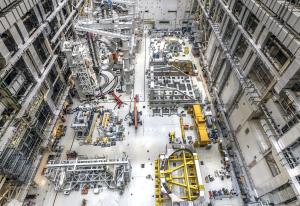Like a Meccano under the Christmas tree
Like Erector set or Meccano parts scattered beneath the tree on Christmas morning, components for the ITER tokamak cover the floor of the Assembly Hall, waiting to be assembled.
On the right, in the foreground, toroidal field #9 is now ready to be upended and installed in one of the sector sub-assembly tools. On the opposite side of the Hall, one of the two outboard thermal shield panel for vacuum vessel sector #1(7) is being prepared for installation. Both components are part of the second vacuum vessel "module," whose central component (the vacuum vessel sector) was docked in the sector sub-assembly tool in late December 2021 (watch this video).
A few steps further along lie elements of the complex rigging used to lift the heaviest ITER components. In light grey, on the left, the sector lifting tool is capable of lifting and balancing loads such as vacuum vessel sectors, toroidal field coils and 1,400-tonne sector sub-assemblies; the yellow dual crane heavy lifting beam, on the right, can rotate the loads 90° for transfer into the V-shaped openings of the tall standing tools.
Farther into the Hall, on the right, the "upending cradle" is tasked with lifting and tilting vacuum vessel sectors and toroidal field coils from horizontal to vertical. Directly across from that stands the first of two 20-metre-tall sector sub-assembly tools, each one currently supporting parts of the ITER vacuum vessel. In the first tool, it is possible to see that thermal shield panels are attached to the open wings, ready to be rotated inwards.
At the far end of the Hall, on the right, we can distinguish a kidney-bean-shaped bottom correction coil parked on temporary supports. Other coils from the same set are already installed in the bottom of the tokamak pit and this one will join them soon.
Finally, a circular platform with ribs—the central solenoid assembly platform—can be seen in the back on the right. The central solenoid modules will be stacked one after another on this platform, encased within a strong supporting structure.
Given the high amount of co-activity in this space, and in the tokamak pit beyond, the ITER construction teams carry out extremely detailed planning and coordination. To learn more about ITER machine assembly and how it is managed, see the new ITER Talks video released in this issue of Newsline.


